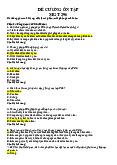

Preview text:
QUẢN TRỊ HỌC (MGT 201) 1. Managemnet
It is the process that coordinating and overseeing the work activities of others so
their activities are completed efficiently and effectively 2. Functions of management - Planning
Defining goals, establishing strategy, and developing subplans to coordinate activities - Organizing
Determining what needs to be done, how it will be done and who is to do it - Leading
Directing and coordinating the work activities of an organizing’s people - Controlling
Monitoring activities to ensure that they are accomplished as planed 3. Skills of management - Conceptual skill
The ability to think and conceptualize about abstract and complex situations - Human skill
The ability to work well with other people individually and in a group - Technical skill
Job-specific knowlegde and techniques needed to proficiently perform work tasks 4. Roles of managers -
Interpersonal roles: Figurehead, Leader, Liasion -
Informational roles: Monitor, Disseminstor, Spokesperson -
Decisional roles: Negatiator, Resource Allocator, Disturbance Handlet, Entrepreneur 5. Problem
A discepancy between an existing and desired state of affairs 6. Decision criteria
Factors that are important to resolving the problem
7. Non-programmed Decision
Decisions that are unique and nonrecurring
Decisions that generate unique responses 8. Risks
A situation in which the manager is able to estimate the likehood of outcomes
that result from the choice of particular alternatives 9. Employee Empowerment
Increasing the decisiong-making authority of employees 10.Team structure
A structurein which the entire organization is made up of work groups or teams 11.Matrix structure
A tructure that assigns specialists form different functional areas to work on
project but who return to their areas when the project is completed 12.Vitual structure
A structure that consists of a small core of full-time employees and that
temporarily hires specialists to work on opportunities that rises
13.Boundaryless organization
An flexible an unstructured organizational design that is intended to break
dowm external barriers between the organization and its consumers and suppliers
14.Demention of leader behavior -
Employee oriented: emphasizing personal relationships -
Production oriented: emphasizing task accomplishment
15.Transactional Leadership
Leaders who guide or motivate their followers in the direction of established
goals by clarifying role and task requiments
16.Transformational Leadership
Leader who inspire followers to transcend their own self-interests for good of
organization by clarifying role and task requiments 17.Controll process - Measuring actual performance -
Comparing actual performance against a standard -
Taking action to correct deviations or inadequate standars 18.Benchmark
The standard of excellence against which to measure and compare
19.Management by walking around (MBWR)
A strategy that emphasizes face-to-face communication in the workplace (direct supervision) 20.Corporate governance
The system by which companies are directed and controlled




